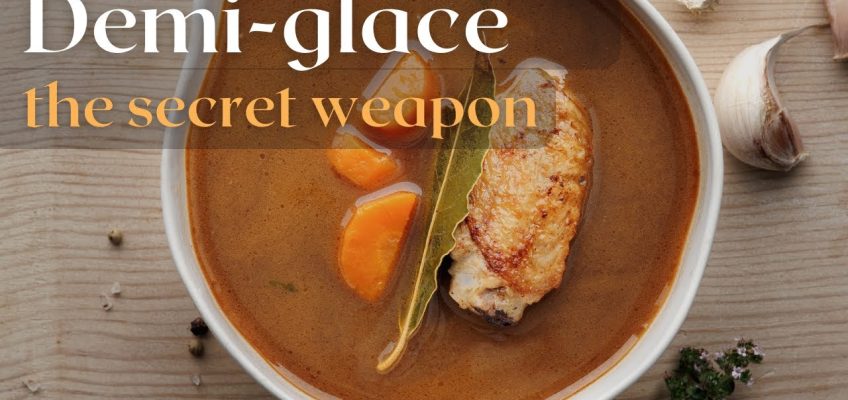Hi guys Stephanie here on the French Cooking Academy and if you're here last Week you'll know we are doing a saucy Series we've started with the pan Sources last week this week we're Continuing talking about classic Standalone sources in this episode we're Going to see the difference between the Two and between the pencils and a Classic Source what are the components And techniques that comes into play and I'm gonna share with you one of my go-to Secret weapon that I use to make an Excellent brand Source base AKA Demi Glass more on that later without Breaking a sweat and this recipe is Actually part of our book so you better Watch this one let's go now we cannot Talk about classic sources without Mentioning the dreaded word matter Sources and their derivative which is Extremely always a topic this is really Confusing so what I've done I've written An article about it and I've put a link In the video description because I don't Want to talk about this in this episode What I want to talk about is the things That I've learned In across the time when I've studied the World of sources and I've made a whole Course about it so I kind of know things Of two-bit Source making now and one Thing I've realized that at home They're really a few key elements that
Are important and that are realistically Usable and easy to use in a home kitchen Okay so and this is what I want to talk With you but before we dive into this Let's look at the difference between the Pan sources and the classic sources so What is the difference the pan sauce is A source that is using the saute deglase Technique okay as we've seen now so you See I use steak and you deglaze with one You add stock you reduce and then you Serve it is a fast and quick sauce made To order the classic sauce on the Internet does not require any of that Searing doesn't require a piece of meat And it is just crafted there and then on Its own but It can be made before the service and it Is made with it can be stalks mixed with Value take and use different technique Different ingredients and it can be made In larger batches so if we take the Example of a borderless source for Instance before the service in a Restaurant someone is gonna make the Right action with vinegar with herbs With red wine and add the stock reduce The thing prepare the sauce in the sauce When it's ready it's going to be sitting Here at the ready when the service is Coming it is in order for a steak It's gonna maybe Grill the steak and Then take a bit of sauce up and that's It these are the classic sauces pan
Sources it is not made before it's Ordered okay that's the main difference Okay now when it comes to the components That comes into the making of classic Sources uh they're quite wide as I said There's a lot of things we could be Talking about so what I'm going to show You now is really Let's do the four things that I found Are really really useful picture on the Screen Now as you can see on the screen these Elements are surely not foreign you got The white stock you go to Seafood stock Or the fish female the bronze stock the Dummy glass and the veluce all of which By the way are included in our Techniques in her upcoming book because You've been asking me what is the type Of content I can't tell you but yes These things are part of it but what I Want to talk about here is the dummy Glass which is really the one that kind Of sits at the odd one out what is the Demi glass it is a stock that has been Enriched with mid trimmings with some Carrots some onion thyme a bit of wine Speaking with flour has been reduced to A semi-crp consistency until it becomes Almost a sauce and I'm saying almost Because the dummy glass is actually a Component a source base that you use in Order to quickly craft all kinds of Brown sources and in the book from
Anthony border Collier this is what he Had to say about the Demi glass this is The good and truly useful thing you want For sources every single Chef has some Form of Jewel as we call it in French or The miglas and which is that Source base Sitting on the side of the bench so that When they have an order and they want to Make a sauce they don't bother with all The nitty-gritty they just add the final Touches very quick the final flavor the Final reduction the touch of spirit Etc This is how professional souls are being Made and this is really what I want to Demonstrate as well in this video so Let's get going The technique I'm going to share with You here will allow you to transform any Pre-made storeboard stocks or cooking Stocks such as this this is a liquid Form thing I got in my Supermarket okay And you can able to transform this in Either a very good brand stock or a demi Glass when I'm mentioning the term Demi-glass I'm not pretending on saying This is the professional thing you've Got in a restaurant and the real Demi-glass I've renamed this the home Style dummy glass on purpose this is my Version that I have adapted to make it Really a home cooking friendly any Store-bought stock can be used VL stock Will use the you know will yield the Best the best taste and we always use
Veal stock in French cooking but you can Use beef stock chicken stock and lamb Stock depending on what you're making so Obviously if you're starting you know Tense towards something quite Mitty if It's purely chicken you can use chicken Stock if it's something with lamb you Rather use lamb stock and so on and so Forth this is going to be the key Element that's going to accelerate Everything and provide lots of flavor Now let's look at the other ingredients We're going to combine with this to make The magic happen Now one of the things that I've tried it On throughout the book that we've made Is to make sure that all the recipe or Almost all the recipe only requires Stuff you're gonna find in your Supermarket so here for that technical Demi glass we need the store-bought Stock you can find this on your Supermarket or in the Delhi and for the Rest let's have a look a tablespoon of Onion a tablespoon of carrot a bay leaf A piece of thyme a teaspoon of tomato Paste a tablespoon of flour I've toasted The flour here in a dry pan so it Doesn't give that whitish color it Brings you a nutty roasty flavor some Peppercorns a bit of wine this is a White one you can use red wine or pot or Whatever you like and these are pieces Of chicken that have cut off what are
These pieces of chicken this is another Trick that I'm doing anytime you buy a Whole chicken you can break it down use The pieces for any recipe and I've Chopped here all the carcass and the Wings and I'm using this to make that Sauce based stocks or the meat glass That Stockade me glass can be used in Stores in the fridge for several days And Frozen for up to three months so it Is really handy and it brings absolutely Zero waste okay so now let's go on the Stove let me show you how we're gonna do It So here we are on the stove the first Thing we're gonna do is to sear or brown The pieces of chicken and this is the Same concept as we've used in the sote De Glacier remember you serious like to Have these caramel juices when you make These sauce babies or any stocks of the Minerals it is the same principle you Need to have that kind of meaty taste so Because we've got a store-bought stock We're going to try to claim back this Meaty flavor and that's why I'm using All these off cuts of chicken so the First thing medium to high heat and We're gonna you know let that oil heat Up I'm studying on a medium to medium high You don't need to go excessively High I Like to bring the temperature bit by bit Okay if your pan is too small take a
Larger pan you don't want to overcrowd Everything so you see I'm using a mini Stock pot And I'm gonna spend a good 10 to 12 Minutes Browning these things You know and I'm gonna raise the heat up So too high when it's going to start to Sizzle After five minutes one I've got a little Bit of color I'm gonna crank up the heat And I'm going to keep on cooking this Until it's really almost dark brown you Don't want to burn anything but you want To make sure that your pieces of chicken Is really well well seared and you got a Maximum of caramel as this is at the Bottom of the pan in this okay so I'll Show you how it looks like when it's Done The Browning process will take you about 12 up to maximum 15 minutes but roughly Speaking this is what I've got these are The kind of color and you see the bottom Of the pan is nice and brown that's the Most important and this is what you want So I'm gonna Reserve my pieces of Chicken here On the side into a sieve to drain the Excess oil and we're going to continue Once you're done with this the same as The as you can see remember we Have the shout out what do we do here is A bit different A medium heat and I'm gonna cook this
Just for a minute or two in My Pan and That's going to capture all of the Leftover oil done don't put your heat Too high because it might burn and Really just a minute even a minute is Enough just to release these flavors in There Very nice I'm gonna follow by adding a Little bit of tomato paste you can add Up to uh you know one or two teaspoon to Give a bit of color and we cook the Tomato paste to remove the acidity and Then we're gonna deglaze Very simple for the wine we can use up To 50 ml if we want Make sure you get a good deglazing And capture everything that's going to Reduce the heat I'm reducing the Heat And on the medium here she immediately We're getting that little base so you Can see the color already very nice and We have done nothing yet so as usual We're going to reduce just until there's Maybe one or two teaspoon left of one It's nice and syrupy what you need to do Take the chicken put it back and we're Gonna mix everything and stir everything Through and then add a little bit of Flour in there because we're gonna want To make a bit of a thickened stock and The tomatoes has to be fixed so to win Time we use a bit of flour I'm not gonna add my toasted flour so Remember toasted flour is not giving
That white aspect the taste of the flour Has been cooked and instead of a flowery Taste you get a Nutty roasty taste okay Look at these lovely colors I've got my Stock on here remember this is the Store-bought stock And I've got a 500 mL I think which is About 2 cup If you want you can top up with a little Bit of water for instance if you make Just a stock but I might leave it there Because we're going to make a quick Version I'm raising my heat I want to bring this To a very light boil and then we're Going to leave it to reduce on the Simmer but to add some flavor I'm adding A few peppercorns A few brunch of time from the garden Nothing special A bay leaf and as a controversial thing Here which is one thing that the new Chefs are doing is to add a tiny weeny Bit of uh so rock salt is rid of few Grains huh Just to kind of release those flavor and That's about it let's wait for the boil To come here So my stock here which at the moment Hasn't been reduced it's still a stock Is now coming to a simmer we're now Gonna do the reduction the same thing as We've done with the pencilses and Depending on what you want to have if
You want a stock to use to braise meat Or whatever you're gonna reduce just by Maybe a quarter or something like this For the mid glass at home the minimum Reduction is by half you reduce but I Have to really get to that semi syrupy The professional World reduced by three Quarters which I think it's it's really Extreme because you end up with no sauce Left so here's this example for kind of A demi glass home style demiglas you Start with two cups of pretty made stock And after reduction we're gonna end up With one stock so I'm Gonna Leave This I'm going to reduce my heat leave this To simmer and let it reduce and that's About it After about 20 minutes of reduction if I'm going towards the dummy glass Territory I am done this is what I've Got I'm gonna filter this through fine Mesh see if put this into another pan so We can look at what we've got here what Revealed what is the end result My home style dummy glass has been Filtered and I've left it a little bit Thinner just to show you and to yield a Bit more in the pan and this is what I've got look at this intense brown Color This is about 30 to 35 minutes of work And you can use that Source base when You make for instance a pencils you can Reduce it a bit more to have it really
Semiciruppy for a standalone source and You can have it thinner but reduce it a Bit less to use for anything like a ragu Bryce meat and that sort of things a lot Of people when they see a stock when it Comes to recipes like oh my God no I'm Not going to make my own stock I'm going To spend the whole day I have to buy Bones and stuff like this not anymore And this is what you're gonna find or One of the recipe from her book in the Technical section and just to tell you There's plenty of other pencils that are In there plus a few standard resources For you to enjoy so there we have it the Home style dummy glass has been revealed It is my secret weapon and it is such a Useful thing to have you can make a Stock you can make a demi-glass and that Opens the door to all kinds of dishes And sauces that you can make and to Demonstrate that next week we're going To use that home style dummy glass and We're going to be making one class six Source is one of the Standalone sources To see the difference what the Difference between the pencils the Classic sources and how to make them but With that trick you will see that Things Become extremely easy and that's gonna Open even more doors and to your Culinary Horizon how to see you next Week on the contribution let's hear you Take care bye
[Music] Dream S [Music] [Music] [Music] Look at me [Music] Don't wanna
Have you ever wondered why most of the Vinaigrettes in the grocery store are made with 10, 20, sometimes even almost 30 ingredients? I remember growing up in Provence watching my mother whipping vinaigrettes before every single dinner. She would mix in a giant bowl, delicious extra virgin olive oil, a robust aged vinegar (the flavor would depend on the main dish), sea salt and pepper and voila! I decided to do the same thing for my family and friends more than 20 years ago here in this beautiful country. And Provence Kitchen® was born. Stay tune for more articles and wonderful family recipes..


Leave a Reply